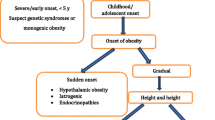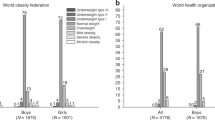Abstract
The study was planned to determine identifiable starting points of a trend towards obesity and the influence of variables in preschool children aged 0 to 6 years. In this longitudinal follow-up study, 102 children were enrolled. Anthropometric measurements such as weight–height centiles (specific for gender and age group), weight–height growth velocities, and body mass indices were taken annually and compared within each group from birth to 6 years. Family history and lifestyle variables were also recorded and compared. Our study has shown that gender does not affect the trend towards obesity. In obese children, the earliest sign of a trend was the rapid increase of weight and weight gain velocity after 6 months. There were upward trends in the BMI values indicating obesity at 1 year of age in boys and at 6 months of age in girls. The height was higher in obese children than in non-obese ones after 4 years of age. Paternal obesity and having an obese sibling were significant risk factors for obesity. In conclusion, 6 months are considered to be the most critical periods for evaluating the development of obesity in childhood. The efforts for preventing obesity should be initiated at 6 months of age.




Similar content being viewed by others
References
Berkowitz RI, Stallings VA, Maislin G, Stunkard AJ (2005) Growth of children at high risk of obesity during the first 6 y of life: implications for prevention. Am J Clin Nutr 81:140–146
Botton J, Heude B, Maccario J, FLVS Study group et al (2008) Postnatal weight and height growth velocities at different ages between birth and 5 y and body composition in adolescent boys and girls. Am J Clin Nutr 87:1760–1768
Bundak R, Furman A, Gunoz H et al (2006) Body mass index references for Turkish children. Acta Paediatr 95:194–198
Cole TJ, Bellizzi MC, Flegal KM, Dietz WH (2000) Establishing a standard definition for child overweight and obesity worldwide: international survey. BMJ 320:1240–1243
Deurenberg P (2001) Universal cut-off points for obesity are not appropriate. Br J Nutr 85:135–136
Dietz WH (1994) Critical periods in childhood for the development of obesity. Am J Clin Nutr 59:955–959
Eriksson J, Forsén T, Tuomilehto J et al (2001) Size at birth, childhood growth and obesity in adult life. Int J Obes 25:735–740
Freedman DS, Khan LK, Mei Z et al (2002) Relation of childhood height to obesity among adults: the Bogalusa Heart Study. Pediatrics 109:e23
Griffiths M, Payne PR, Stunkard AJ et al (1990) Metabolic rate and physical development in children at risk of obesity. Lancet 336:76–78
Grundy SM (1998) Multifactorial causation of obesity: implications for prevention. Am J Clin Nutr 67:563–572
Guo SS, Huang C, Maynard LM et al (2000) Body mass index during childhood, adolescence and young adulthood in relation to adult overweight and adiposity: the Fels Longitudinal Study. Int J Obes Relat Metab Disord 24:1628–1635
Helsinki Declaration (http://www.wma.net/en/30publications/10policies/b3/17c.pdf)
Lagström H, Hakanen M, Niinikoski H et al (2008) Growth patterns and obesity development in overweight or normal-weight 13-year-old adolescents: the STRIP study. Pediatrics 122:876–883
Lissau I, Overpeck MD, Ruan WJ et al (2004) Health behaviour in school-aged children obesity working group. Body mass index and overweight in adolescents in 13 European countries, Israel, and the United States. Arch Pediatr Adolesc Med 158:27–33
Lobstein T, Baur L, Uauy R, IASO International Obesity Task Force (2004) Obesity in children and young people: a crisis in public health. Obes Rev 5:4–104
McCarthy A, Hughes R, Tilling K et al (2007) Birth weight; postnatal, infant, and childhood growth; and obesity in young adulthood: evidence from the Barry Caerphilly Growth Study. Am J Clin Nutr 86:907–913
Rasmussen F, Johansson M (1998) The relation of weight, length and ponderal index at birth to body mass index and overweight among 18-year-old-males in Sweden. Eur J Epidemiol 14:373–380
Reilly JJ (2002) Assessment of childhood obesity: national reference data or international approach? Obes Res 10:838–840
Roberts SB, Savage J, Coward WA et al (1988) Energy expenditure and intakes of infants born to lean and overweight mothers. N Engl J Med 318:461–466 [Abstract]
Sachdev HS, Fall CHD, Osmond C et al (2005) Anthropometric indicators of body composition in young adults: relation to size at birth and serial measurements of body mass index in childhood in the New Delhi birth cohort. Am J Clin Nutr 82:456–466
Safer DL, Agras WS, Bryson S, Hammer LD (2001) Early body mass index and other anthropometric relationships between parents and children. Int J Obes Relat Metab Disord 25:1532–1536
Sorensen HT, Sabroe S, Rothman KJ et al (1997) Relation between weight and length at birth and body mass index in young adulthood: cohort study. Br Med J 315:1137
Stunkard AJ, Berkowitz RI, Schoeller DA, Stallings VA (2004) Predictors of body size in the first 2 years of life: a high-risk study. Int J Obes Relat Metab Disord 28:503–513
Wang Y, Lobstein T (2006) Worldwide trends in childhood overweight and obesity. Int J Pediatr Obes 1:11–25
WHO Expert Committee on Physical Status (1995) Physical status: the use and ınterpretation of anthropometry. World Health Organization, Geneva
Acknowledgements
Statistical analysis was made in a professional bureau by Emire Bor. Thanks to Arzu Aslan for helping the secretariat.
Conflict of interest
None
Author information
Authors and Affiliations
Corresponding author
Rights and permissions
About this article
Cite this article
Yücel, O., Kinik, S.T. & Aka, S. Diagnosis of a trend towards obesity in preschool children: a longitudinal study. Eur J Pediatr 170, 751–756 (2011). https://doi.org/10.1007/s00431-010-1343-z
Received:
Accepted:
Published:
Issue Date:
DOI: https://doi.org/10.1007/s00431-010-1343-z




